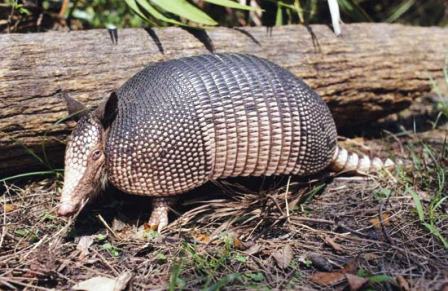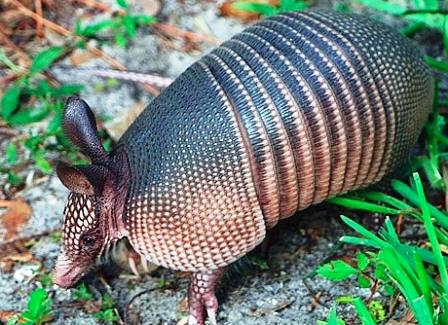Discover Florida Nature
It's time to explore the natural Florida


|
|
|
|
|
 Armadillos
are small placental mammals, known for having a leathery armor shell.
The word armadillo is Spanish for "little armored one". In the
United States, the sole resident armadillo is the Nine-banded Armadillo,
which is most common in the central southernmost states. Armadillos have
been consistently expanding their range over the last century due to a
lack of natural predators. Armadillos
are small placental mammals, known for having a leathery armor shell.
The word armadillo is Spanish for "little armored one". In the
United States, the sole resident armadillo is the Nine-banded Armadillo,
which is most common in the central southernmost states. Armadillos have
been consistently expanding their range over the last century due to a
lack of natural predators. The nine-banded armadillo, named for the nine breaks in the creature’s leathery armor that allow it to flex its stiff hide, is an odd-looking mammal about the size of a cat. A mature armadillo is 15 to 17 inches long (not counting the tail) with a weight of eight to 17 pounds. Armadillos have a shield-like shell covered with horny scales. Joints in the shell are flexible, which enable the animal to bend and twist. Only the ears and belly of the armadillo are without bony armor. These peculiar animals have 28-32 peg-like teeth in simple rows well back in the mouth. There are no front teeth. Armadillos have poor eyesight and hearing, but a keen sense of smell. Both males and females are about the same size, look alike, and have similar habits. Despite their awkward appearance, armadillos are agile runners and good swimmers. Armadillos were not always present in Florida. During the past century, they expanded their range from Texas into the Florida panhandle. Armadillos are now found in uplands throughout Florida, except in the Keys and parts of the Everglades and Big Cypress swamp. Armadillos like forested or semi-open habitats with loose textured soil that allows them to dig easily. Armadillos tend to frequent the vicinity of streams and water holes, although they seem to avoid marshy areas. Tracks in the mud around small ponds give evidence that the armadillos visit them not only for purposes of drinking and feeding, but also to take mud baths. Armadillos are fascinating mammals. When they need to cross narrow water bodies, they often walk on the bottom under water. If it is a wide body of water, they will inflate their stomach to twice its normal size, allowing for enough buoyancy to swim across. When startled, armadillos often leap high into the air, and then run quickly to a nearby burrow. Armadillos dig burrows for homes or to escape predators, and a single armadillo can have several different burrows with multiple entrances.  Armadillos
feed primarily on insects and their larvae. They also eat earthworms,
scorpions, spiders,
snails, and small vertebrates and their eggs. Reports of armadillo
damage to birds' nests on the ground are rare. People cannot help but
appreciate the fact that armadillos consume large amounts of armyworms,
cockroaches, ants, wasps, flies,
beetles, and grasshoppers. They have
been known to dig up entire yellow-jacket nests. Armadillos usually
search for food by rooting or digging in ground litter, but will
occasionally eat berries and mushrooms. Armadillos
feed primarily on insects and their larvae. They also eat earthworms,
scorpions, spiders,
snails, and small vertebrates and their eggs. Reports of armadillo
damage to birds' nests on the ground are rare. People cannot help but
appreciate the fact that armadillos consume large amounts of armyworms,
cockroaches, ants, wasps, flies,
beetles, and grasshoppers. They have
been known to dig up entire yellow-jacket nests. Armadillos usually
search for food by rooting or digging in ground litter, but will
occasionally eat berries and mushrooms. Armadillos prolific rooting and burrowing can severely damage lawns and flower-beds. To reduce armadillo damage to your lawn keep watering and fertilization to a minimum. Moist soil and lush vegetation bring earth worms and insect larvae (armadillo candy!) to the surface of the soil. Also, watering gardens in the morning is preferable since the soil can dry out in the afternoon and not be as easily detected by night-foraging armadillos. Although armadillos breed in late July, the 5-month gestation period is delayed which results in the young being born in February or March. Only one litter is produced each year. Pregnant females always give birth to identical quadruplets. She produces one egg that splits into four identical offspring that are either all female or all male. This trait differs from most other mammals. Compared to other common mammals such as raccoon and opossum, armadillos are remarkably free of parasites. Rabies has never been diagnosed in armadillos in Florida. In 1971, a captive armadillo developed leprosy 17 months after it was inoculated with the bacterium Mycobacterium leprae obtained from an infected human. Subsequently, armadillos have been used in further study of this disease. Armadillos are one of the most common victims of highway mortality in Florida. The armadillo's instinctive response of jumping upwards when startled may be effective at avoiding a lunging predator, but not an automobile or truck passing overhead. Also, many are killed by dogs and coyotes. |
|
|
Advertise | Privacy Statement | Dog Encyclopedia | Video |Contact | Alaska Nature |
|